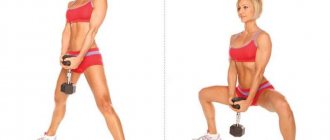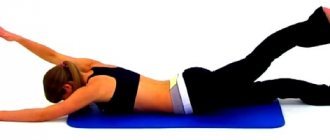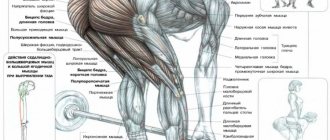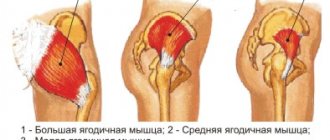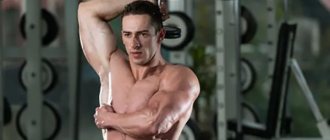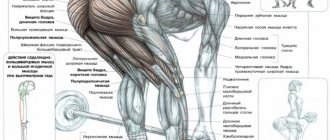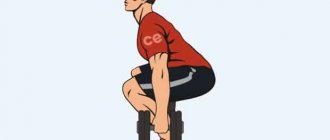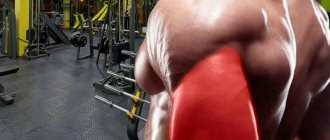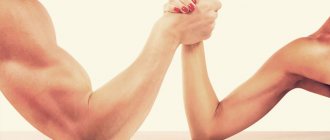The core muscles (translated from the English “core” - center) perform certain functions: stabilizing the pelvis and spine, maintaining balance and maintaining the health of the entire musculoskeletal system. For the Russian-speaking population, it is easier to associate “core muscles” with the main consonant function of these muscles, which are a corset for the skeletal system. Performing the function of a corset, the “centre muscles” hold the body in the correct (physiological) position. Training these muscles is necessary not only for athletes to improve athletic performance, but also for those who want to keep all body systems healthy.
Where are the core muscles located and what functions do they perform?
The core muscles (or core muscles) are a conditional group of muscles that hold the spine and pelvic region in a stable position. It is impossible to master any sports discipline, doing strength sports or fitness, with weak core muscles. Without tone of the muscles that fix vulnerable parts of the spine and joints, increasing loads can only injure or aggravate problems.
Core muscles include:
- rectus abdominis muscle;
- external oblique abdominal muscles;
- internal oblique muscles of the abdomen;
- transverse abdominis muscle;
- back extensors;
- gluteal muscles;
- hamstrings;
- tensor fascia lata;
- rectus femoris muscle;
- tailoring;
- leading.
Thus, the muscles of the center can be both external and internal. These muscles are conventionally located in the center of the body and hold the spine, pelvis and hips not only under load, but also at rest. They are interconnected, uniform tone of the core muscles ensures balance between the front and rear groups, maintaining correct posture in an upright position.
Consequences of core weakness
With atony or hypotonicity (weakening), the core muscles do not hold the vertebrae or joint in the correct position, and the unfixed section seems to bulge forward. Hypertonicity is also not a plus for muscles, which, being in an overstrained and pinched state, pull the “blanket” over themselves and compensate for the state of atonic muscles.
For example, consider core muscle dysfunction:
- Weakness of the gluteal muscles , the posterior or anterior group of thigh muscles provokes a forward displacement of the pelvis, visual flattening (smoothing, leveling) of the buttocks.
- Weakness of the transverse and rectus abdominis muscles forms a bulging abdomen and hypertonicity of the lumbar extensors, which are in a enslaved state and increase lordosis, that is, the lower back is in an unnatural deflection.
Core stability can be detrimental
Constant tension in your core muscles can create and cause back pain. For chronic pain in patients when moving, which leads to further compression of the intervertebral discs.
affect the stability of the spine differently. Retracting the abdominal muscles was ineffective. Tension of these muscles increases spinal stability but also increases compression of the vertebrae. The most effective was the natural work of the core muscles.
In patients with back pain, tension in the abdominal muscles increases intraperitoneal pressure, which can affect the pelvic area.
It is better to relax the core muscles than to constantly tense them. People who lift weights often experience psychological stress due to the need to think about the core. increases muscle contraction, increases pressure on the vertebrae and makes movements less flexible.
Patients suffering from chronic back pain often exaggerate their discomfort. Excessive concerns about core stability cause a person to constantly think about back pain, which only makes the problem worse. Lederman tries to divert his patients' attention away from large backs and abdominal muscles and discourages extensive back strengthening. This behavior will ease psychological stress and alleviate pain.
Finally, worrying about core stability distracts a person from the issues that really need to be addressed when dealing with pain. Excessive focus on core stability can make the problem chronic.
The benefits of core training
By training your core muscles you can get a number of benefits:
- In strength sports, when lifting heavy weights, the core muscles maintain stability of the spine and pelvis, preventing injury.
- Strong core muscles allow you to build strength and endurance faster.
- Core training helps you achieve proper posture.
- Improves coordination and balance, increasing the level of stress where it is necessary to maintain balance.
- The tone of these muscles directly affects the condition of the internal organs, increasing blood circulation and relieving tension due to incorrect position of the spine and pelvis.
Best Core Exercises
An exercise is considered effective if it engages multiple muscles and joints (see multi-joint exercises) throughout the torso at the same time, which work together to maintain balance and stability. Some of the best exercises are simple bodyweight exercises. Here is a list of the most basic and effective:
- Dragon flag;
- Plank;
- Side plank;
- Push ups;
- Squats;
- V-shaped rise of the body;
- Gluteal bridge;
- Lifting the hips from a lying position;
- Turning the torso to the sides from a sitting position;
- Plank on fitball;
- Lunge with torso rotation;
- Exercise "Superman".
General recommendations for core training
To strengthen your core muscles, it is important to focus on sensations, being aware of which muscles are working at the moment. For girls, core muscle training does not involve working with weights. In the future, both men and women can use the equipment. Exercises can be either static or dynamic.
Important! You can't train your core muscles every day.
The complex, including warm-up and stretching, should last no more than an hour.
- For beginners, all exercises are performed once with multiple repetitions.
- If you are prepared, you can perform the complex in 3 approaches.
- If the exercise is performed statically , it must be held for approximately 5-7 breathing cycles (1 cycle: inhale-exhale) or 30-60 seconds, depending on preparation.
- Dynamic exercises should be performed for 16, 24, 32 repetitions.
How to train your core muscles?
First, let's look at the general principles of core training:
- The increase in training loads should be gradual. Beginners with a weak level of general physical fitness should start with the simplest exercise options and gradually, as their strength increases, complicate their workouts.
- There is no need to focus on pumping just the abdominals. Core workouts should be varied and include different exercises for different muscles.
- To avoid cross-loading, it is best to train your core muscles after heavy squats and deadlifts to avoid under-recovery.
- To avoid muscles becoming accustomed to the load and to “reach” previously unaffected muscles, the set of exercises needs to be changed every 2-3 months.
- Exercises for the core muscles can be performed in 2-3 approaches or in 2-3 circles; if the movement is done “to complete failure”, the number of approaches can be reduced to one.
- During your free time from training, you should constantly monitor your posture.
- To add an aesthetic component to strength training, adjust your diet by reducing “fast” carbohydrates in your diet and adding protein.
- There are training systems in which core exercises are included “by default.” A striking example is functional training. You can practice using similar methods and the core muscles will definitely not remain forgotten.
Who needs to work on their core muscles?
The general recommendation sounds banal: everyone needs to work on their core muscles. This is an extremely important muscle complex, maintaining which in good shape is necessary for everyone for health and decent appearance.
However, there are several main groups of people who especially need targeted core training:
- People who are seriously involved in various sports - to obtain insurance against injuries and improve their athletic performance.
- People involved in fitness for health and a beautiful body - that is, those who, although they do not have serious sporting ambitions, nevertheless regularly train to maintain good physical shape and achieve a sporty appearance.
- Those who are engaged in heavy physical labor, as well as people for whom good physical fitness is a prerequisite for professional compliance (law enforcement officers, circus performers, rescuers, etc.).
- For people who have a sedentary job and lead a sedentary lifestyle - to maintain the health of the spine and internal organs, and combat congestion in the bloodstream.
Basic core exercises
The core consists of a large number of different muscles, and it is basically impossible to pump it up with one universal exercise. Below are examples of various exercises for core training, divided (rather roughly) into groups.
Core exercise groups:
- Various types of planks (straight, side) and their modifications.
- Various exercises for pumping up the abs: crunches, leg or torso lifts, etc.
- Hyperextensions on the floor or on a special machine
- Glute bridges and their variations
- Push-ups and their modifications
- Lateral bends for the obliques with or without weights.
- Exercises on the horizontal bar and parallel bars: lifting legs to the crossbar, knees to chest, various static “corners”, etc.
What other exercises develop the core:
- Most exercises with fitball
- Most kettlebell exercises
- Most gliding exercises
- Most medicine ball exercises
- Rope climbing
- Deadlifts and squats
- Lunges and their modifications (mainly for the hip adductors, gluteus minimus and gluteus medius)
Below are ready-made exercise plans for core training.
Nutrition for Effective Core Training
The core is a collection of muscles, therefore, in nutrition during core training, you need to adhere to the same principles as when training other muscles. A good help for the trainee would be to increase the amount of protein in the diet to approximately 2 g per 1 kg of weight, with a parallel decrease in the proportion of fats and quickly digestible carbohydrates in the diet.
Remember, to see the long-awaited six-pack and flat stomach, it is not enough to just train your core muscles. It is also necessary to monitor your diet in order to burn the fat layer that forms on the stomach most rapidly. If you want to reduce the percentage of body fat, then try to follow the principles of proper nutrition and maintain a calorie deficit (eating less than the body can burn). Without correcting your diet, even regular intense workouts will not help you achieve a toned body. Be sure to watch: PROPER NUTRITION where to start step by step.
The Best Exercises to Train Your Core Muscles at Home
Plank
A static exercise that involves all the muscles of the center at the same time.
- Place your hands under your shoulders, your feet the width of your pelvic bones.
- Tighten your stomach, tighten your buttocks, squeeze your shoulder blades together.
- Pull the top of your head forward.
- Hold the position without holding your breath.
Learn more about the plank exercise →
Exercise "swimming"
Strengthening the core of the body, stretching and strengthening the back, arms and legs.
- Starting position on all fours: hands under the shoulders, knees under the pelvis.
- At the same time, extend your arm and the opposite leg, straightening it until it is parallel to the floor as you inhale.
- Exhale, lower your arm and knee and switch sides.
- Keep your stomach tense, avoiding arching in the lumbar region.
Concentrate on lengthening your muscles.
Twist up/down
The transverse abdominal muscle is strengthened and the hamstrings are stretched.
- Sitting on your buttocks, bend your knees, place your heels on the floor, and keep your hands in front of you.
- Having stretched the top of your head, inhale, then as you exhale, slowly lower yourself onto your back, vertebra by vertebrae, starting from the tailbone.
- At the bottom, take a breath and just as slowly lift your neck, and so on, each section one by one, without jerking or using your hands.
Fully straighten your spine at the top.
Shoulder bridge
The shoulder bridge exercise develops the muscles of the thighs and buttocks.
- Lie on your back, place your heels under your knees, the width of your pelvic bones.
- Inhale, and as you exhale, lift your buttocks, as if you were twisting your pelvis, tearing off vertebrae by vertebrae, but do not collapse your chest towards your neck.
- Inhale at the top, and just as slowly lay your back on the floor.
Oblique crunches
Strengthens the core muscles, mainly the obliques and rectus abdominis, shaping the waistline.
- Lie on the floor, keeping your shins parallel to the floor.
- Place your hands behind your head.
- Lift your shoulder blades off the floor and hold the position until the end of the approach.
- Inhale, and as you exhale, twist your body to the side: elbow to the opposite knee.
- As you inhale, return to the center and repeat the twist in the opposite direction.
Useful information about the core muscles
The core muscles are a whole complex of muscles that are responsible for stabilizing the pelvis, hips and spine.
Core muscles include:
- Obliques
- Transverse abdominis
- Straight thigh m.
- Small and medium gluteal m.
- Leading m.
- M. posterior thigh
- Podostnaya m.
- Coracobrachial m.
Core – the biomechanical area of the center of gravity (also referred to as the body or torso). The core muscles are deep muscles that lie next to the spine and provide its fixation. Core training – training the core of the body and building a strong foundation around the spine. Initially, core training was associated with exercises for the transverse abdominal muscle. This muscle is the deepest muscle layer of the abdominal wall. It is designed to hold the internal organs in place, gives the waist a slim appearance and is responsible for stabilizing the lumbar region.
Three facts about the core muscles:
1. These are the only muscles that can be strengthened by remaining motionless. Unlike any other skeletal muscle, it doesn't move your bones. Their task is to keep the pelvis, spine and hips in a stable, safe position. This is why all exercises that strengthen the core muscles are, to one degree or another, uncomfortable and unstable. 2. Strengthening your core does allow you to maintain beautiful posture and a healthy spine, but one hour of training a week cannot compensate for 50 hours of sedentary work in a defiantly anxious posture. If you want a straight back and a cubic belly, work on your posture. When sitting at the computer, do not lean forward or cross your legs, and keep your shoulders down and slightly back. 3. Any complex movement begins with a contraction of the core muscles. Only after they have started working is the force transmitted through the arms and legs to the barbell or dumbbells. A weak center gives weak commands, so if your results in bench presses or squats have stopped growing, pay attention to your core.
As a rule, when we talk about pull-ups, we believe that their number depends, first of all, on the strength of the arms. Perhaps because of the strength of the back (although those who pull a lot but cannot pull themselves up will disagree with this). But almost no one believes that pull-ups depend on the core and abdominal muscles. In fact: what does this have to do with muscles that are not involved in pull-ups at all? This is about the same as saying that pull-ups depend on leg strength. For the average person, it’s funny, but Dan Jones and Louis Simmons would desperately support this statement. So: pull-ups are a complex exercise that involves almost all the muscles of our body. In addition, body shape is very important in pull-ups: the stronger the frame, the easier it will be for you to string more pull-ups onto it. A simple example: pregnant women practically cannot do pull-ups. Not because they are weak or their center of gravity has changed: simply because, thanks to pregnancy, the core muscles are very relaxed and practically do not support the body during such a complex movement as pull-ups.
Accordingly, the load falls only on the arms, which, of course, cannot pull the body weight. How many people do you know who can lift 50-60 kilograms using only their biceps? Unlikely. Personally, I definitely can’t do that. This simple example clearly shows that without developed core muscles there is no point in even thinking about doing a serious amount of pull-ups. But what muscles are we even talking about?
What is “core” and where is it located?
"Cor" from the English "core", which actually means "center" or "core". There is still no clear definition of what the “core” is, but in general everyone agrees on one thing: these are the muscles that transmit force between our “upper” and “lower” halves. In fact, if you look more closely, this is what it turns out to be: we have the upper torso, legs, and what connects them. This “layer” will be the core muscles.
In addition, the core muscles are designed to transmit force from bottom to top or top to bottom. The body is a completely interconnected system, so the faster and more efficiently a given force is transmitted, the greater the effect will be when performing a variety of exercises. In this regard, you can also add the following picture:
Naturally, in this position, the core muscles will be responsible for the position of our body in space, for orientation. As we can see, the seemingly simplest positions at first led us to a very difficult conclusion: without correctly and effectively developed core muscles, there is nothing to think about increasing results in complex multi-joint exercises: squats, deadlifts, pull-ups. It can and should be said that the core muscles are NOT just the abdominal muscles, as beginners in fitness often think. This is a significant percentage of our muscle tissue and without paying enough attention to them, we risk either stagnating in results, or over time getting injured out of the blue.
Exercises to develop core muscles:
1. Side bridge
Lie on your side with your feet together and rest your forearm on the floor, placing it directly under your shoulder. Tightening your abdominal and back muscles, lift your pelvis off the floor, bringing your body in line with your legs. Hold this position for 15-45 seconds and repeat on the other side. Important: additionally tense your abdominal and buttock muscles in order to keep your body perfectly straight.
2. Plank position
Take a lying position, standing on your forearms. Place your feet either together or shoulder width apart. Raise your right arm diagonally forward and to the right “at 2 o’clock”, hold this position for 2 seconds and return to the starting position. Repeat with the other hand and you get one rep. Important: in the starting position, the forearms should be perpendicular to the shoulders, and the elbows should be strictly under the projection of the shoulder joints.
3. Alternate lowering of legs while lying down
Lie on your back with your legs straight above you. Arch your back, pressing your lower back firmly into the floor, and slowly lower one leg without touching the floor. Return to the starting position and repeat with the other leg. As you lower, imagine that you are extending your leg, moving your heel away from your pelvis. Important: keep your toes pointed towards you and start moving from your heel.
4. Grouping on a fitball
Take a lying position with your shins on the fitball. With your hands slightly wider than your shoulders, tighten your abdominal muscles and pull your knees toward your chest. Slowly return to the starting position without arching and maintaining a rounded back. Important: at the end point of the movement, lean on the ball only with your toes. Your shins should come completely off the surface of the ball.
5. The Lumberjack in Love
Kneel in front of the pulley device after attaching a rope handle to it. Pull the handle towards you, first pulling the rope towards your chest, and then, continuing the movement, turn your body and move the handle down and back. Return to the starting position and repeat the turn in the other direction. Important: do not tilt your body or bend your back; keep your abdominal muscles tense while turning.
6. Knee shaft
Lie on your back with your knees bent together. Lift your socks off the floor and, straining your buttocks, lift your pelvis up. Maintaining this position, pull your right knee towards your chest. Working in reverse, return to a lying position and repeat on the other leg. Important: make sure that the pelvis remains motionless in the raised position.
Best Workout Programs
Technical
If you start your training by strengthening your core muscles, your technique for doing regular squats will improve literally before your eyes - the awakened center will allow the body to transfer force much more efficiently. The result is a pleasant bonus in the form of more solid weights and larger muscles. Execution: do a side bridge (1) and a plank position (2) in a row. Hold the bridge for 15-45 seconds, and do 8-12 repetitions for each arm in the plank. Perform this routine before every strength session.
Medical
Does your back hurt? Movement is the best medicine! This complex will gently strengthen the core muscles, which will allow you to more evenly distribute body weight along the spine and relieve unnecessary stress from the lower back.
Execution: do the knee roll (6) without rest - 6-12 repetitions, plank position (2) - 4-12 repetitions, love lumberjack (5) - 6-10 repetitions, side bridge (1) - 5-45 seconds. This will be one circle. Rest for a minute and repeat the circle a couple more times. Perform the program at the end of your workout 2-3 times a week.
Olympic
If the core muscles are weakened, it is no longer possible to run, jump, or fight at full strength. Use this circuit training and you can improve your performance in any sport.
Execution: without rest, do plank position (2) - 4-12 repetitions, knee roll (6) - 6-12 repetitions, fitball tuck (4) - 6-12 repetitions, love lumberjack (5) - 6-10 repetitions, side bridge (1) - 15-45 seconds for each side, alternating lying leg lowering (3) - 6-12 repetitions. Rest for a minute and repeat the entire circuit. Perform the program at the end of your workout 2-3 times a week.
